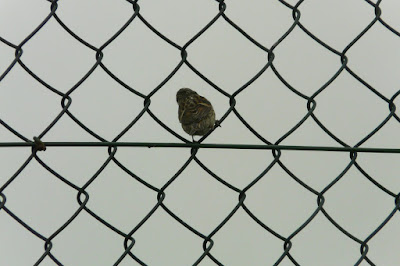The other day I sat watching a play with two star characters:
The Parent Pied Wagtail, Motacilla alba.
 and
andthe Juvenile Pied Wagtail, Motacilla alba

It was quite comical to watch the Parent foraging with the Kid following eagerly for the next worm or Insect.
The Kid went of exploring on its own too, of course; one needs to find out what is behind that shrub, evelation, or tree.





 In short, I spend a delightful time here at the side of the road, my eyes, camera and bins transfixed on the theatre set.
In short, I spend a delightful time here at the side of the road, my eyes, camera and bins transfixed on the theatre set.Next I rode on along the bay, looking longingly towards the pier. The breeze, as ever, was too strong to go and sit here out into the open, so I decided against it, and as I watched the Sea Asters, which finally were coming into bloom. I'd been waiting for these little little Wild Flowers, which last summer attracted so many Small Tortoiseshell Butterflies. I have only seen a few of these yet, which I do hope will be changing soon. To be honost, the ones I did see this summer, were all back in the garden. As I looked down, I spotted a Gull flying up, while I was thinking how odd it was to see a totally white one. Besides this strange plumage, I noticed that it would be too large for one too. I've seen big Great Black backed Gulls, Lesser Black backed or Heron Gulls, but this one beat all of those. Not that these were all white, far from it!
Following it, it landed in a across the bay. Heading back to the Church of Ireland, I spotted two Little Egrets in one tree, another Little Egret and Grey Heron in another, nearby.
The discovery of the latter was odd and yet it brought a smile to my face. The Grey Herons breed and rooast in a tree across the pier, and usually fish here too. The Egrets I had not seen in the bay since last year. I've seen Little Egrets in Bantry Bay, but not here in Dunmanus Bay. they have eluded me since. Whenever I would see the 'white Herons' here, one Grey Heron had been with them, everytime.
I am sorry, it was too far across for my dear Lumix. Besides the problem of distance, the other was white blobs in the tree. The sun was beaming right onto the birds, and even adjustments couldn't change this, without any visible details.
The botanical photos will be on Wildlife on Wheels. Not many either, because the break in the clouds was not very tolerable; wind and looming rain meant that I soon had to turn back again.
Yet it had been fun observing the Wagtails. I love juvenile Wagtails, their grey colour reminds me a bit of female Chaffinches, which would probably love such a large black bib too!




























